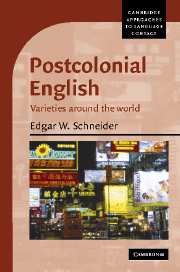Book contents
- Frontmatter
- Contents
- List of maps, figures, and tables
- Series editor's foreword
- Preface and acknowledgments
- List of abbreviations
- 1 Introduction
- 2 Charting the territory: Postcolonial Englishes as a field of linguistic investigation
- 3 The evolution of Postcolonial Englishes: the Dynamic Model
- 4 Linguistic aspects of nativization
- 5 Countries along the cycle: case studies
- 6 The cycle in hindsight: the emergence of American English
- 7 Conclusion
- Notes
- References
- Index of authors
- Index of subjects
6 - The cycle in hindsight: the emergence of American English
Published online by Cambridge University Press: 15 December 2009
- Frontmatter
- Contents
- List of maps, figures, and tables
- Series editor's foreword
- Preface and acknowledgments
- List of abbreviations
- 1 Introduction
- 2 Charting the territory: Postcolonial Englishes as a field of linguistic investigation
- 3 The evolution of Postcolonial Englishes: the Dynamic Model
- 4 Linguistic aspects of nativization
- 5 Countries along the cycle: case studies
- 6 The cycle in hindsight: the emergence of American English
- 7 Conclusion
- Notes
- References
- Index of authors
- Index of subjects
Summary
It is not customary to view American English as one of the “New” or Postcolonial Englishes. It is typically regarded as an “old,” established, “Inner Circle” variety, one of the world's two major “reference accents” – quite unlike the newly emerging varieties discussed in chapter 5. However, such a perspective may be misguided simply by the fact that American English originated considerably earlier than these other varieties. On second thoughts, it cannot be denied that it emerged very much like the Englishes of Australia, New Zealand, and South Africa did much later, and the difference to other PCEs is essentially one of colonization type and of a more prolonged time depth, not a matter of principle. English-speaking North America started out as Britain's first overseas colonial offspring, and the early American settlers met with indigenous people and had to deal with them in much the same way British expatriates did in many locations around the globe centuries later. The fundamental similarities may have been obscured by the remarkable political and economic success of the United States in the twentieth century that turned her into a global superpower. Basically, however, as I will show momentarily, American English has proceeded along the same developmental cycle as the others.
American English thus provides an almost unique opportunity to observe the entire developmental cycle in hindsight, as it were.
- Type
- Chapter
- Information
- Postcolonial EnglishVarieties around the World, pp. 251 - 308Publisher: Cambridge University PressPrint publication year: 2007



